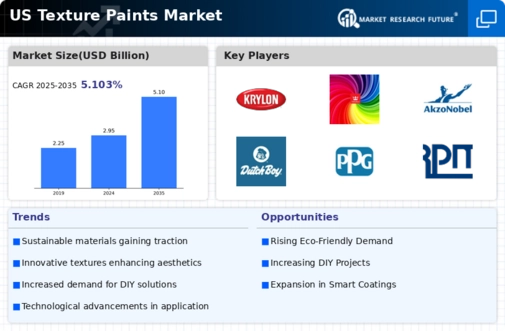The US Texture Paints Market is witnessing significant growth as a result of increasing demand for aesthetic and functional paint solutions across various applications, including residential, commercial, and industrial sectors. The competition among leading manufacturers is intensifying, with companies striving to innovate and enhance their product offerings to capture a larger market share. Various factors such as the rising popularity of decorative finishes, an increase in home renovation activities, and heightened awareness about the benefits of texture paints are driving competition.
Additionally, the growing trend of eco-friendly and sustainable paint options is compelling manufacturers to refine their formulations to align with consumer preferences, making this market dynamic and rapidly evolving.Krylon stands out as a notable player in the US Texture Paints Market, leveraging its strong brand recognition and wide product range. The company's commitment to quality and innovation has established it as a trustworthy name among consumers and professionals alike. Krylon's products are designed to meet diverse customer needs, from spray paints that create textured finishes to specialty coatings that offer durability and environmental resistance.
Its extensive distribution network enables strong market presence, and the company benefits from a loyal customer base bolstered by its longstanding reputation for excellence. The strategic focus on enhancing product formulations and launching new textures caters to evolving market demands, solidifying Krylon's competitive position within the industry.Behr Paint Company also plays a significant role in the US Texture Paints Market, known for its comprehensive array of high-performance paints and related products. Recognized for quality and innovation, Behr offers a variety of texture paint options that cater to both residential and commercial projects, supporting varied aesthetic demands.
The company's key products include textured finishes that enhance durability and visual appeal, aligning with consumer preferences for distinctive creative styles. Behr’s market presence extends through partnerships with major home improvement retailers and regional distribution channels, ensuring accessibility to a wide customer base. The company's commitment to sustainability is also reflected in its product lines, which appeal to environmentally conscious consumers.
In recent years, Behr has focused on strategic mergers and acquisitions to further strengthen its market position, effectively expanding its product portfolio and enhancing its capability to meet consumer expectations in the competitive landscape of the US Texture Paints Market.














